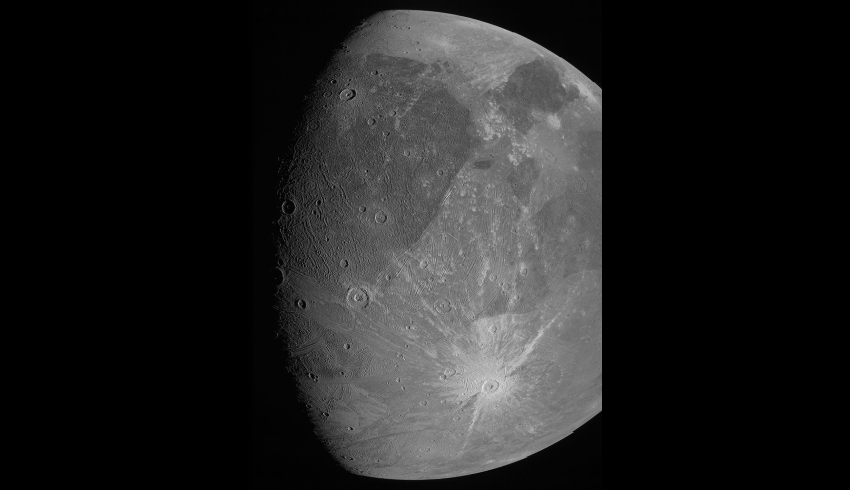Ganymede is bigger than the planet Mercury, and is the only moon in the solar system that boasts its own magnetosphere.
The photos represent the closest a spacecraft has ever come to the solar system’s largest natural satellite since the agency’s Galileo spacecraft made its approach in 2000, with the Juno spacecraft coming within 1,038 kilometres of its surface.
“This is the closest any spacecraft has come to this mammoth moon in a generation,” said Juno principal investigator Scott Bolton of the Southwest Research Institute in San Antonio.
“We are going to take our time before we draw any scientific conclusions, but until then we can simply marvel at this celestial wonder.”
Captured by Juno’s JunoCam, the pictures show the surface of the icy giant moon in great detail, including its craters, varied terrain, and “long structural features possibly linked to tectonic faults”, NASA said, and are now the most detailed pictures available of Ganymede.
JunoCam’s visible-light imager was able to capture nearly an entire side of the icy moon through its green filter, with image resolution sitting at about one-kilometre per pixel.
Additional versions of the same photos are expected to be sent to Earth over the coming days, which will also utilise the camera’s red and blue filters, giving NASA a full colour portrait of Ganymede.
Meanwhile, the spacecraft’s Stellar Reference Unit, a navigation camera that keeps the spacecraft on course, has also sent a black-and-white image of the moon’s dark side, with a resolution of between 600-900 metres per pixel.
“The conditions in which we collected the dark side image of Ganymede were ideal for a low-light camera like our Stellar Reference Unit,” said Heidi Becker, Juno’s radiation monitoring lead at JPL.
“So this is a different part of the surface than seen by JunoCam in direct sunlight. It will be fun to see what the two teams can piece together.”
Juno is expected to continue sending data and photos to Earth over the coming days.
The flypast of Jupiter was announced by NASA just days ago.
NASA said the trip is expected to yield new insights into the composition of Ganymede, as well as its ionosphere, magnetosphere, and icy shell, and produce striking new images of the moon.
“Juno carries a suite of sensitive instruments capable of seeing Ganymede in ways never before possible,” said Bolton.
“By flying so close, we will bring the exploration of Ganymede into the 21st century, both complementing future missions with our unique sensors and helping prepare for the next generation of missions to the Jovian system – NASA’s Europa Clipper and ESA’s [European Space Agency’s] JUpiter ICy moons Explorer [JUICE] mission.”
NASA said Juno will utilise its Microwave Radiometer’s (MWR) will peer into Ganymede’s water-ice crust, to gain a deeper understanding of the icy crust’s composition and its temperature.
“Ganymede’s ice shell has some light and dark regions, suggesting that some areas may be pure ice while other areas contain dirty ice,” said Bolton.
“MWR will provide the first in-depth investigation of how the composition and structure of the ice varies with depth, leading to a better understanding of how the ice shell forms and the ongoing processes that resurface the ice over time.”
The results will complement those from ESA’s forthcoming JUICE mission, NASA said, which will look at the ice using radar at different wavelengths when it becomes the first spacecraft to orbit a moon other than Earth’s moon in 2032.
Radio signals sent up by Juno will be picked up by two antennas based at the Deep Space Network’s Canberra-based facility.
Due to the speed of the fly-by, Juno will be able to capture just five images, as the icy moon moves into and out of JunoCam’s viewpoint within the space of just 25 minutes.
“Things usually happen pretty quick in the world of fly-bys, and we have two back-to-back next week. So literally every second counts,” said Juno mission manager Matt Johnson of JPL.
“On Monday, we are going to race past Ganymede at almost 12 miles per second (19 kilometres per second). Less than 24 hours later we’re performing our 33rd science pass of Jupiter – screaming low over the cloud tops, at about 36 miles per second (58 kilometres per second).
“It is going to be a wild ride.”

Hannah Dowling
Writer – Defence and Aerospace, Momentum Media
Hannah joined Momentum as a journalist in 2019, and has since written breaking news stories across a diverse range of corporate industries, including finance, real estate, investments and aviation. She has a keen interest in the global aviation sector, with a particualy focus on improving overall individual wellbeing across the aerospace industry.
Hannah graduated from Macquarie University in Sydney Australia with a Bachelor of Media (Journalism) and is currently pursuing postgraduate studies.
Send Hannah an email at [email protected] or connect via Twitter or LinkedIn.

